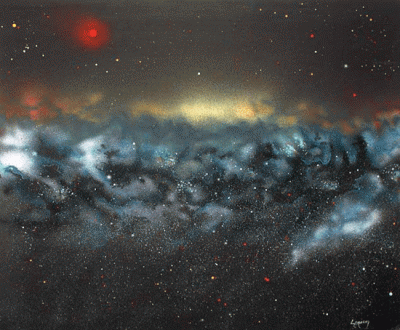Jon Lomberg has a distinction of which few humans can boast — he knows his art will last. As the designer of the cover of the Voyager Interstellar Record, Lomberg created an aesthetic statement that could, in fact, last for a thousand million years. As could the entire sequence of 120 photographs and diagrams that he designed for the Voyager record. And just to show that his interest in deep time isn’t purely space-related, Lomberg also designed a 10,000 year nuclear waste marker for the US Department of Energy. Centauri Dreams appreciates all instances of genuinely long-term thinking, but particularly celebrates the marriage of art with technology in time-frames longer than our civilization.
It seems fitting, then, that when Lomberg turns to SETI issues, he would bring an artist’s eye to the proceedings, which is what he does in an article written with Guillermo Lemarchand (Centro de Estudios Avanzados, Universidad de Buenos Aires). The essay, called “SETI and Aesthetics” and available online, points out that our SETI strategy depends upon the assumed transmission strategies of any civilizations about which we hope to learn. Are there, then, ‘universal’ principles of science and aesthetics that may reasonably be expected among sentient beings?
If so, these are surely what any intelligent race would use when attempting to make contact with other civilizations, for random transmission strategies would make the odds of contact so small as to be insignificant. SETI researchers have done much with scientific deductions, such well known variables as selecting the best frequencies (i.e., the famous ‘waterhole’ wavelengths), choosing the best target stars, deducing the best interstellar bandwidth, and so on. But what about elegance and design?

Image: A Lomberg image from COSMOS. This frame from the original television series storyboards shows the galactic center setting behind the disk of the galaxy as we enter the Milky Way.
Lomberg wants to expand our list of SETI factors by studying universal symmetries, which appear widely not only in nature but also in human artwork. Here he discusses radial symmetry, an arrangement based on radii emanating from a common center:
In Earth’s biosphere radial symmetry is found throughout many phyla and kingdoms, from the shells of radiolarians to the growth patterns of colonial algae, from the lotus flower to the octopus, from the spider’s web to the human eye.
In human art radial symmetry is one of the commonest design motifs in the world, equally obvious in the stonework of Gothic and Aztec masons, in the symbols of Chinese and Navajo people, in the religious iconography of Tibet and family crest design in Japan. Indeed, mandala patterns are among the few designs found in almost every human culture known…
Applying radial symmetry to SETI, Lomberg’s belief is that a commonly recognized unique point would be any center which both civilizations (transmitting and receiving) have in common. In the Milky Way, that unique point is the center of the galaxy. “If there are many transmitting civilizations in the galaxy, some other civilizations may exist along the same radius as the Sun,” he adds. “These civilizations would therefore occupy a privileged position over other galactic locations from the point of view of symmetry. Radial symmetry thus offers a solution to the question of where in the sky interstellar beacons might preferentially be directed and found.”
A reasonable deduction, then, is that the search for interstellar beacons should be concentrated in a deep field survey along the radius connecting between us, the galactic center and the galactic anti-center, offering a field of 108 stars and increasing the time we could spend on candidate sources dramatically by reducing the field of view. Another benefit is to simplify the question of relative motion by relating it to the galactic barycenter as a common rest frame.
This is a rich paper that goes on to explore both the omnipresence of Phi (the constant of proportionality, also known as the Golden Section and the Divine Proportion), and forms of bilateral symmetry found throughout the biosphere, considering what they may tell us about creating a strategy for communicating with radically different cultures in a refined, targeted SETI hunt. Lomberg, who is well known as the principal artistic collaborator of Carl Sagan and chief artist for the COSMOS television series, infuses SETI possibilities with aesthetic concerns that seem an entirely reasonable extrapolation of what an advanced culture might choose to deliver in a galaxy-spanning signal.
For more on Lomberg’s thinking, be aware of an upcoming interview on the Australian Broadcasting Corporation’s Science Show, to be aired Saturday the 19th and available over the Net.

